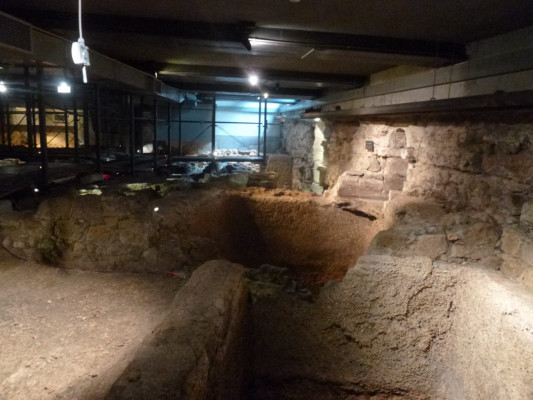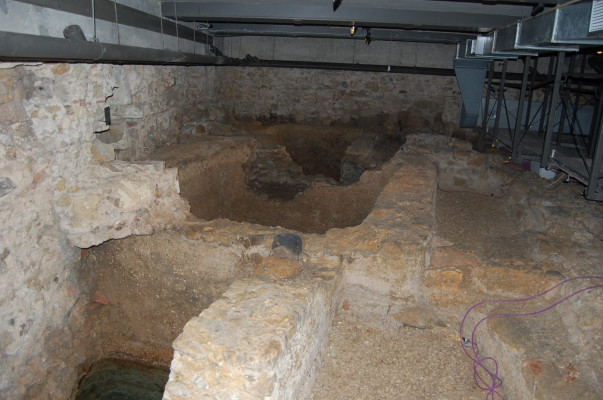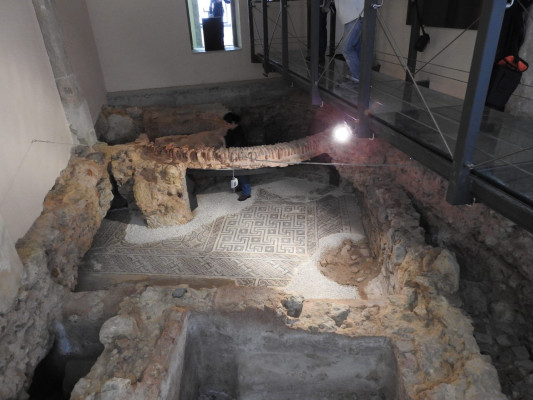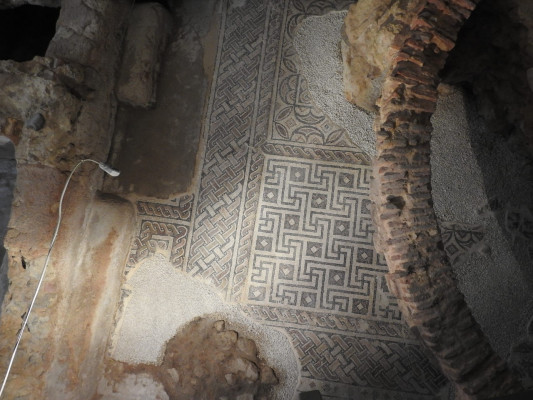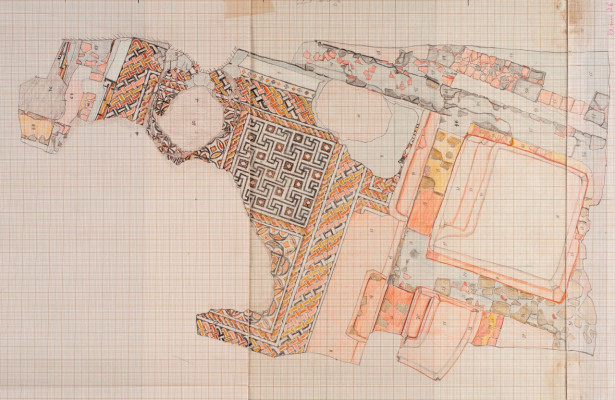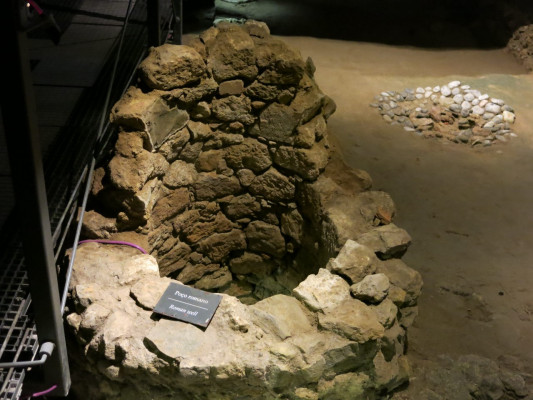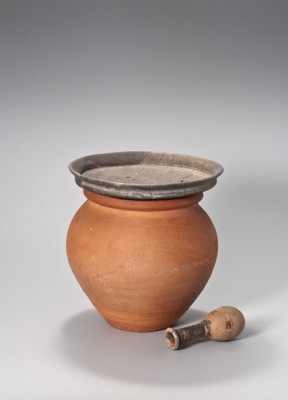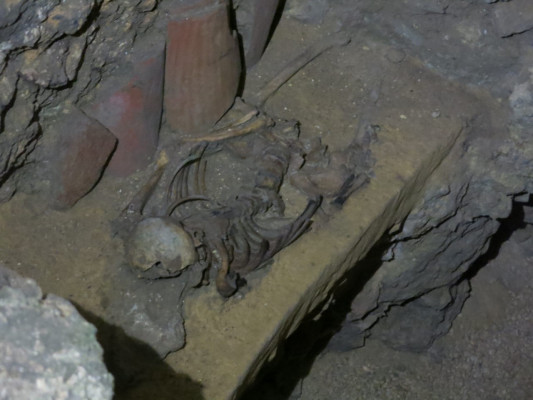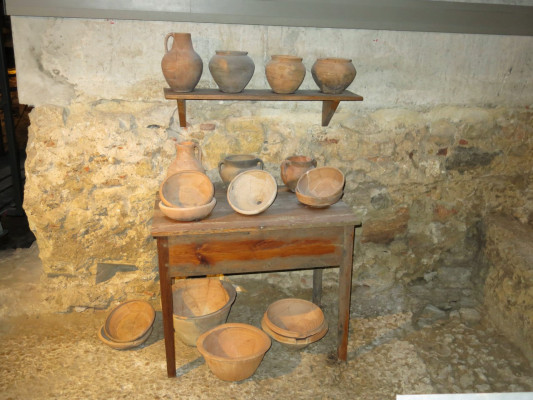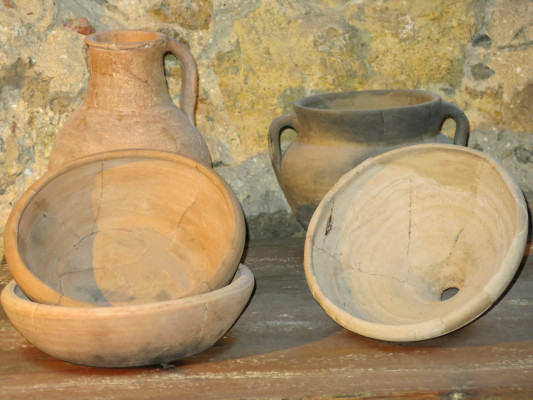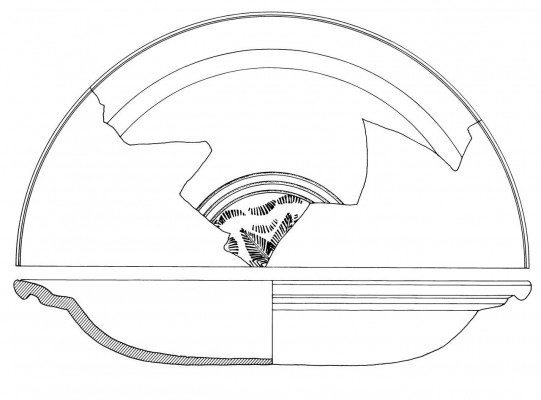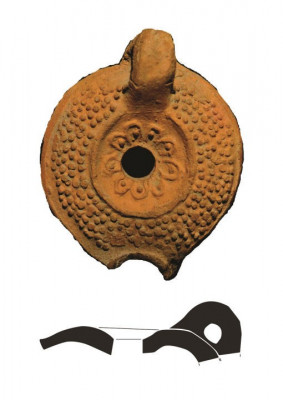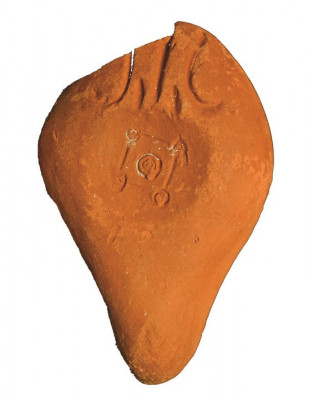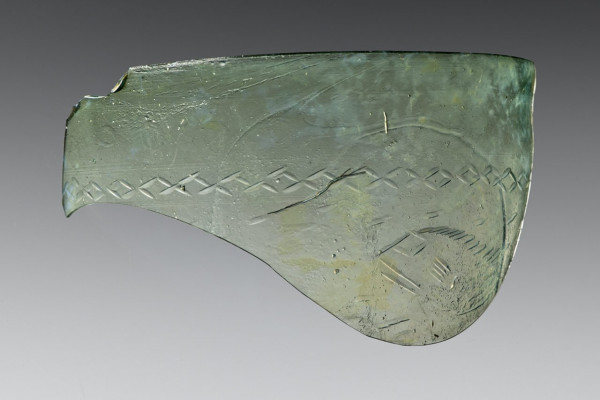Choose locations to explore
Select the desired period of history
1st century BC - 6th century AD
Rua dos Correeiros Archaeological Nucleus (NARC)
This area of downtown Felicitas Iulia Olisipo - near the Tagus shore and the river branch that, at the time, connected the Arroios and Valverde river streams, which ran aboveground and converged in the present area of Praça da Figueira - was just outside the city walls, near the city's Southwestern via (road).
After the mid-1st century BC, the area was used as a funerary area, where rituals of inhumation and cremation were practiced, but in the mid-1st century AD, a fish products production complex was built over this necropolis. The complex was active until the 5th century AD. Archaeological excavations identified 31 cetariae (tanks used to salt fish) and some support structures, as well as a residential area. Excavations also discovered part of a house and its bathing facilities, with several pools and bathtubs. One room in particular still retains its mosaic pavement.
The archaeological collection is representative of the important and abundant local and regional ceramic production, but also of the great trade dynamics of the Felicitas Iulia Olisipo port, as indicated by the presence of several ceramic recipients imported from Baetica (Roman province corresponding roughly to present-day Andalusia), Italy and North Africa.
After this factory was abandoned, in the 5th century AD, the roadway continued to be used and this area recovered its peri-urban character, as evidenced by an isolated tomb from the High Middle Ages.
After the mid-1st century BC, the area was used as a funerary area, where rituals of inhumation and cremation were practiced, but in the mid-1st century AD, a fish products production complex was built over this necropolis. The complex was active until the 5th century AD. Archaeological excavations identified 31 cetariae (tanks used to salt fish) and some support structures, as well as a residential area. Excavations also discovered part of a house and its bathing facilities, with several pools and bathtubs. One room in particular still retains its mosaic pavement.
The archaeological collection is representative of the important and abundant local and regional ceramic production, but also of the great trade dynamics of the Felicitas Iulia Olisipo port, as indicated by the presence of several ceramic recipients imported from Baetica (Roman province corresponding roughly to present-day Andalusia), Italy and North Africa.
After this factory was abandoned, in the 5th century AD, the roadway continued to be used and this area recovered its peri-urban character, as evidenced by an isolated tomb from the High Middle Ages.
Add to route
Multimedia
The industrial belt of Olisipo
Typology
City | Urbs, House | Domus, Road, Well, Necropolis, Fish preparations
Archeological interventions
1991; 1993-1995; 2017
Suggested reading
Amaro, C., ed. (1995) - Núcleo Arqueológico Rua dos Correeiros. Lisboa: Fundação Banco Comercial
Português.
Bugalhão, J. (2001) - A indústria romana de transformação e conserva de peixe em Olisipo. Núcleo
Arqueológico da Rua dos Correeiros (Trabalhos de Arqueologia; 15). Lisboa: Instituto Português de
Arqueologia.
Bugalhão, J. (2017) - O eixo viário ocidental de Olisipo. In Debaixo dos Nossos Pés. Pavimentos históricos de Lisboa. Lisboa: Museu de Lisboa, pp. 120-123.
Bugalhão, J.; Arruda, A. M.; Sousa, E.; Duarte, C. (2013) - Uma necrópole na praia. O cemitério romano do Núcleo Arqueológico da Rua dos Correeiros (Lisboa). Revista Portuguesa de Arqueologia, Lisboa: DGPC. 16, pp. 243-275.
Português.
Bugalhão, J. (2001) - A indústria romana de transformação e conserva de peixe em Olisipo. Núcleo
Arqueológico da Rua dos Correeiros (Trabalhos de Arqueologia; 15). Lisboa: Instituto Português de
Arqueologia.
Bugalhão, J. (2017) - O eixo viário ocidental de Olisipo. In Debaixo dos Nossos Pés. Pavimentos históricos de Lisboa. Lisboa: Museu de Lisboa, pp. 120-123.
Bugalhão, J.; Arruda, A. M.; Sousa, E.; Duarte, C. (2013) - Uma necrópole na praia. O cemitério romano do Núcleo Arqueológico da Rua dos Correeiros (Lisboa). Revista Portuguesa de Arqueologia, Lisboa: DGPC. 16, pp. 243-275.
Address
Rua dos Correeiros, 21, Lisboa
Useful links
Rua dos Correeiros Archaeological Nucleus | Website - https://www.fundacaomillenniumbcp.pt/nucleo-arqueologico/
Rua dos Correeiros Archaeological Nucleus | Archaeologist Portal - http://arqueologia.patrimoniocultural.pt/index.php?sid=sitios&subsid=48414
Rua dos Correeiros Archaeological Nucleus | Archaeological object - http://www.matriznet.dgpc.pt/MatrizNet/Objectos/ObjectosListar.aspx?TipoPesq=2&NumPag=1&RegPag=50&Modo=1&Criterio=NARC
Rua dos Correeiros Archaeological Nucleus | Archaeologist Portal - http://arqueologia.patrimoniocultural.pt/index.php?sid=sitios&subsid=48414
Rua dos Correeiros Archaeological Nucleus | Archaeological object - http://www.matriznet.dgpc.pt/MatrizNet/Objectos/ObjectosListar.aspx?TipoPesq=2&NumPag=1&RegPag=50&Modo=1&Criterio=NARC
Identification code
LxR1106002
Cookies
All cookies used by www.lisboaromana.pt website are for the technical storage or transmission of communication through an electronic communications network.
The website www.lisboaromana.pt also uses language cookies for website users. These cookies have a duration of one year. See our Cookie policy

